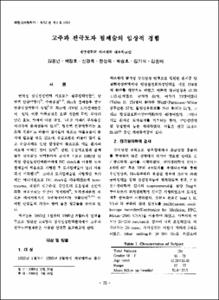KUMEL Repository
1. Journal Papers (연구논문)
1. School of Medicine (의과대학)
Dept. of Internal Medicine (내과학)
고주파 전극도자 절제술의 임상적 경험
- Alternative Author(s)
- Kim, Yoon Nyun; Han, Seong Wook; Hur, Seung Ho; Kim, Kee Sik; Kim, Kwon Bae
- Journal Title
- 대한내과학회지
- ISSN
- 1226-329x
- Issued Date
- 1997
- Abstract
- Objectives : Among the current therapeutic options for paroxysmal supraventricular tachycardias, only surgery and ablative techniques are curative. However, surgery is associated with substantial cost, morbidity, and rarely death. Recently, catheter ablation techniques have been developed to treat paroxysmal supraventricular tachycardias. These techniques are effective and low-risk curative treatment for supraventricular tachycardias. This article shall describe our clinical experiences in radiofrequency catheter ablation for supraventricular tachycardias and review the literature.
Methods The study population consisted of 154 patients with supraventricular tachycardias from January 1993 to August 1995. Eighty one patients were men and seventy three patients were women, and their mean age was 41.29±15.41 years. Radio-frequency currents(mean) were applied through a catheter electrode positioned against the mitral or tricuspid annulus or a branch of the coronary sinus or atrioventricular node.
Results: Among 154 patients, the mechanisms for paroxysmal supraventricular tachycardias were found to be atrioventricular reentrant tachycardia involving a concealed accessory pathway in 51(33.1%), Wolff-Parkinson-White syndrome in 57(37%), and atrioventricular nodal reentrant tachycardia in 46 (29.9%). Successful outcomes were achieved in 46 of 46 patients (100%) with atrioventricular nodal reentrant tachycardia, 7 of 8 patients(87.5%) with double accessory pathways, 69 of 72 patients(95.8%) with left-sided accessory pathway, and 19 of 28 patients (67.9%) with right-sided accessory pathway. Total 141 of 154 patients(91.6%) with supraventricular tachycardias had a successful outcome with radio-frequency current application(mean).
Conclusions: Radiofrequency catheter ablation techniques are highly effective in ablating accessory pathways or modifying atrioventricular node, with morbidity and no mortality.
Key Words: Radiofrequency, Catheter ablation, Supraventricular tachycardia.
연구 배경 : 상심실성 빈맥의 치료에 비약물적 치 료법으로 도자절제가 이용되고 있으며,이는 약물적 요법과는 달리 상심실성 빈맥의 일부 형태에서 근본적 인 치료가 가능하고 외과적 수술요법과는 달리 개흉하 지 않으며 시술에 따른 합병증의 병발이 수술에 비해 현저히 적다. 또한 환자에게 주는 고통이 현저히 적고, 높은 성공율등의 장점으로 상심실성 빈맥의 치료에 가 장 중요한 치료법으로 인식되고있다. 저자등은 154명 의 환자를 대상으로한 고주파전극도자절제술의 경험올 보고하고,다른 보고를 살펴보고자 한다.
대상 및 방법 : 1993년 1월부터 1995년 8월까지 빈맥올 주소로 입원한 154명의 상심실성 빈맥환자롤 대상으로 하였고, 이들의 평균연령은 41.29士15.41세 이고,남자가 81명 여자가 73명이었다. 이들 환자에게 삼첨판막륜,승모판막륜과 방실결절부위에 위치한 절 제도자를 통해 30-60volt의 고주파에너지를 20sec-30sec동안 가하여 도자절제술을 시행하였다.
결 과 : 154명의 환자중 Wolff-Parkinson-White 증후군은 57예(37%)이었고 불현성 우회로를 갖은 환 자는 51예(33.1%)이었으며 46예(29.9%)는 방실결절 회귀성빈맥을 보였다. 위치별로는 좌측에 한개의 우회 로를 가진 환자는 72명(66.7%)이었고 우측에 한개의 우회로를 가진 환자는 28명(25.9%)이었으며 2개의 우 회로를 동시에 갖은 환자가 8예(7.4%)였다.
시술의 성공여부는 방실결절 회귀성빈맥은 전예 (100%)에서,두개의 우회로를 갖은 환자에서는 8예중 7예(87.5%)에서, 좌측에 우회로를 갖은 환자에서는 72예중 69예(95.8%)에서, 우측에 우회로를 갖은 환자 에서는 28예중 19예(67.9%)에서 성공하였으며,전체 154명중 141명(91.6%)에서 성공하였다.
결 론 : 고주파 전극도자절제는 수술과 비슷한 정 도의 성공올올 보이고 발생되는 합병증도 적어 인력이 나 장비가 잘 갖추어진 검사실에서는 상심실성 빈맥의 치료에 우선적으로 사용되어야할 것으로 생각된다.
- Alternative Title
- Clinical Experiences in Radiofrequency Catheter Ablation
- Department
- Dept. of Internal Medicine (내과학)
- Publisher
- School of Medicine
- Citation
- 김윤년 et al. (1997). 고주파 전극도자 절제술의 임상적 경험. 대한내과학회지, 52(1), 75–82.
- Type
- Article
- ISSN
- 1226-329x
- Appears in Collections:
- 1. School of Medicine (의과대학) > Dept. of Internal Medicine (내과학)
- 파일 목록
-
-
Download
 oak-bbb-00676.pdf
기타 데이터 / 585.39 kB / Adobe PDF
oak-bbb-00676.pdf
기타 데이터 / 585.39 kB / Adobe PDF
-
Items in Repository are protected by copyright, with all rights reserved, unless otherwise indicated.